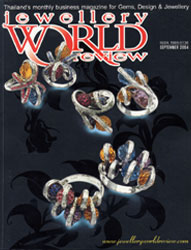The
Gemological Institute of America has released the Summer 2004 issue
of its award-winning quarterly journal, Gems & Gemology. This
issue contains a guide to US laws on gem treatment disclosure, plus
a first report on a new commercial source of synthetic diamonds
-- all accompanied by spectacular photography.
The legal requirements for disclosing gem treatment
have grown broader and more comprehensive in recent years. In the
lead article, "Gem Treatment Disclosure and US Law," G&G
Managing Editor Thomas W. Overton offers detailed suggestions for
avoiding legal problems. Mr Overton, an attorney and a gemologist,
discusses the development of the Federal Trade Commission guides
for the gem and jewelry industry as well as relevant state laws
and other issues such as civil fraud. the article includes a review
of actual case studies demonstrating the risks of inadequate disclosure,
as well as a practical guide for disclosure of commonly encountered
gem treatments.
"As the requirements to disclose treatments
become more stringent, anyone who sells gems must be aware of the
legal ramifications of nondisclosure or inadequate disclosure, "
said Editor-in-Chief Alices S.Keller. "This article clearly
spells out what gem merchants need to know so they can fulfill their
obligations and protect themselves." |
|
 Photo copyright GIA 2004.
Photo copyright GIA 2004. |
Also
featured is a report on a new commercial source of laboratory grown
diamonds in colorless, yellow, blue, and pink hues, which are being
distributed by Chatham Created Gems of San Francisco, California.
The increasing commercial availability and natural-looking appearance
of these synthetic diamonds underscores the need for reliable methods
of identification. This article, written by GIA Director of Research
Dr.James E.Shigley and colleaques, characterizes the material and
provides identifying characteristics.
The Summer issue also takes a fresh look at the
use of infrared spectroscopy to identify synthetic amethyst. Over
the last 15 years, the presence of a 3543 cm-1 absorption band in
the IR spectrum has gained wide spread acceptance as an identifying
feature of synthetic amethyst. Yet this new investigation , by Russian
researcher Dr. Vladimir S. Balitisky and colleagues, concludes that
the 3543 cm-1 absorption band should only be considered a possible
indication of synthetic origin, as it is not present in all synthetic
amethyst and is not as rare in natural amethyst as was once believed.
To make a positive identification, the article proposes, gemologists
should use a combination of infrared spectra, internal growth structures,
and inclusions.
The Lab Notes column delivers the latest discoveries
from the GIA Gem Laboratory, including a notable cat's-eye alexandrite,
a dyed and fracture-filled "pink" diamond, and the use
of photoluminescence spectroscopy to idenfity a natural purple-pink
spinel. The Gem News International section covers the world of gemology,
with reports on recent US patents for diamond fingerprinting methods;
scapolite from Mozambique; tourmaline and other minerals from Warner
Springs, California and "shell pearls." To order a copy
of the Summer 2004 issue visit www.gia.edu, or
contact Debbie Ortiz at dortiz@gia.edu. |



